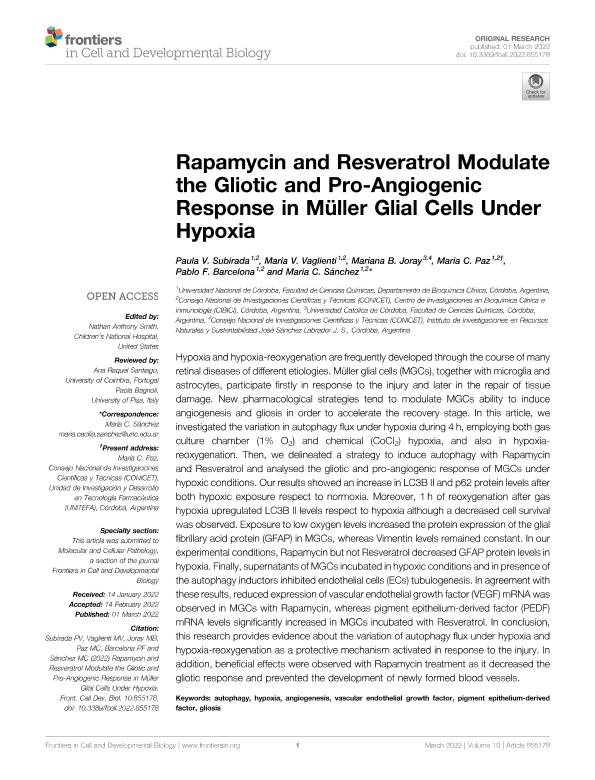Mostrar el registro sencillo del ítem
dc.contributor.author
Subirada Caldarone, Paula Virginia

dc.contributor.author
Vaglienti, María Victoria

dc.contributor.author
Joray, Mariana Belén

dc.contributor.author
Paz, Maria Constanza

dc.contributor.author
Barcelona, Pablo Federico

dc.contributor.author
Sánchez, María C.
dc.date.available
2023-07-13T12:40:29Z
dc.date.issued
2022-03
dc.identifier.citation
Subirada Caldarone, Paula Virginia; Vaglienti, María Victoria; Joray, Mariana Belén; Paz, Maria Constanza; Barcelona, Pablo Federico; et al.; Rapamycin and Resveratrol Modulate the Gliotic and Pro-Angiogenic Response in Müller Glial Cells Under Hypoxia; Frontiers Media; Frontiers in Cell and Developmental BiologY; 10; 855178; 3-2022; 1-14
dc.identifier.uri
http://hdl.handle.net/11336/203660
dc.description.abstract
Hypoxia and hypoxia-reoxygenation are frequently developed through the course of many retinal diseases of different etiologies. Müller glial cells (MGCs), together with microglia and astrocytes, participate firstly in response to the injury and later in the repair of tissue damage. New pharmacological strategies tend to modulate MGCs ability to induce angiogenesis and gliosis in order to accelerate the recovery stage. In this article, we investigated the variation in autophagy flux under hypoxia during 4 h, employing both gas culture chamber (1% O2) and chemical (CoCl2) hypoxia, and also in hypoxia-reoxygenation. Then, we delineated a strategy to induce autophagy with Rapamycin and Resveratrol and analysed the gliotic and pro-angiogenic response of MGCs under hypoxic conditions. Our results showed an increase in LC3B II and p62 protein levels after both hypoxic exposure respect to normoxia. Moreover, 1 h of reoxygenation after gas hypoxia upregulated LC3B II levels respect to hypoxia although a decreased cell survival was observed. Exposure to low oxygen levels increased the protein expression of the glial fibrillary acid protein (GFAP) in MGCs, whereas Vimentin levels remained constant. In our experimental conditions, Rapamycin but not Resveratrol decreased GFAP protein levels in hypoxia. Finally, supernatants of MGCs incubated in hypoxic conditions and in presence of the autophagy inductors inhibited endothelial cells (ECs) tubulogenesis. In agreement with these results, reduced expression of vascular endothelial growth factor (VEGF) mRNA was observed in MGCs with Rapamycin, whereas pigment epithelium-derived factor (PEDF) mRNA levels significantly increased in MGCs incubated with Resveratrol. In conclusion, this research provides evidence about the variation of autophagy flux under hypoxia and hypoxia-reoxygenation as a protective mechanism activated in response to the injury. In addition, beneficial effects were observed with Rapamycin treatment as it decreased the gliotic response and prevented the development of newly formed blood vessels.
dc.format
application/pdf
dc.language.iso
eng
dc.publisher
Frontiers Media

dc.rights
info:eu-repo/semantics/openAccess
dc.rights.uri
https://creativecommons.org/licenses/by-nc-sa/2.5/ar/
dc.subject
ANGIOGENESIS
dc.subject
AUTOPHAGY
dc.subject
GLIOSIS
dc.subject
HYPOXIA
dc.subject
PIGMENT EPITHELIUM-DERIVED FACTOR
dc.subject
VASCULAR ENDOTHELIAL GROWTH FACTOR
dc.subject.classification
Bioquímica y Biología Molecular

dc.subject.classification
Ciencias Biológicas

dc.subject.classification
CIENCIAS NATURALES Y EXACTAS

dc.title
Rapamycin and Resveratrol Modulate the Gliotic and Pro-Angiogenic Response in Müller Glial Cells Under Hypoxia
dc.type
info:eu-repo/semantics/article
dc.type
info:ar-repo/semantics/artículo
dc.type
info:eu-repo/semantics/publishedVersion
dc.date.updated
2023-07-07T21:39:21Z
dc.identifier.eissn
2296-634X
dc.journal.volume
10
dc.journal.number
855178
dc.journal.pagination
1-14
dc.journal.pais
Suiza

dc.description.fil
Fil: Subirada Caldarone, Paula Virginia. Universidad Nacional de Córdoba. Facultad de Ciencias Químicas. Departamento de Bioquímica Clínica; Argentina. Consejo Nacional de Investigaciones Científicas y Técnicas. Centro Científico Tecnológico Conicet - Córdoba; Argentina
dc.description.fil
Fil: Vaglienti, María Victoria. Consejo Nacional de Investigaciones Científicas y Técnicas. Centro Científico Tecnológico Conicet - Córdoba; Argentina. Universidad Nacional de Córdoba. Facultad de Ciencias Químicas. Departamento de Bioquímica Clínica; Argentina
dc.description.fil
Fil: Joray, Mariana Belén. Universidad Católica de Córdoba. Instituto de Investigaciones en Recursos Naturales y Sustentabilidad José Sanchez Labrador S. J. Consejo Nacional de Investigaciones Científicas y Técnicas. Centro Científico Tecnológico Conicet - Córdoba. Instituto de Investigaciones en Recursos Naturales y Sustentabilidad José Sanchez Labrador S. J.; Argentina
dc.description.fil
Fil: Paz, Maria Constanza. Universidad Nacional de Córdoba. Facultad de Ciencias Químicas. Departamento de Bioquímica Clínica; Argentina. Consejo Nacional de Investigaciones Científicas y Técnicas. Centro Científico Tecnológico Conicet - Córdoba; Argentina
dc.description.fil
Fil: Barcelona, Pablo Federico. Universidad Nacional de Córdoba. Facultad de Ciencias Químicas. Departamento de Bioquímica Clínica; Argentina. Consejo Nacional de Investigaciones Científicas y Técnicas. Centro Científico Tecnológico Conicet - Córdoba; Argentina
dc.description.fil
Fil: Sánchez, María C.. Universidad Nacional de Córdoba. Facultad de Ciencias Químicas. Departamento de Bioquímica Clínica; Argentina. Consejo Nacional de Investigaciones Científicas y Técnicas. Centro Científico Tecnológico Conicet - Córdoba; Argentina
dc.journal.title
Frontiers in Cell and Developmental BiologY
dc.relation.alternativeid
info:eu-repo/semantics/altIdentifier/url/https://www.frontiersin.org/articles/10.3389/fcell.2022.855178/full
dc.relation.alternativeid
info:eu-repo/semantics/altIdentifier/doi/http://dx.doi.org/10.3389/fcell.2022.855178
Archivos asociados
